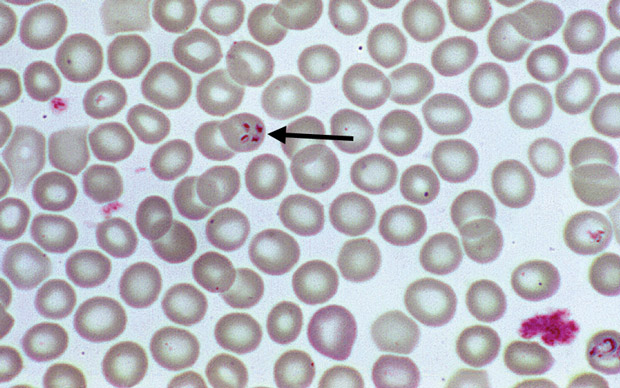MKSAP Quiz: Fatigue, anorexia, and myalgia
A 68-year-old woman is hospitalized with fatigue, anorexia, and myalgia worsening over the last week. She underwent laparotomy 4 weeks ago for trauma sustained in a motor vehicle accident, which necessitated a splenectomy. She received 3 units of blood as well as pneumococcal, haemophilus, and meningococcal vaccination; she was discharged on postoperative day 8. Hemoglobin level at discharge was 11 mg/dL (110 g/L). Her only medication is acetaminophen as needed for pain.

On physical examination, temperature is 38.6°C (101.5°F), blood pressure is 138/63 mm Hg, pulse rate is 92/min, and respiration rate is 18/min. The examination is otherwise noncontributory.
Laboratory studies:
| Hemoglobin | 9.9 g/dL (99 g/L) |
| Leukocyte count | 10,100/µL (10.1 × 109/L) with 82% neutrophils, 2% bands, 11% lymphocytes, 3% monocytes, and 2% atypical lymphocytes |
| Platelet count | 92,000/µL (92 × 109/L) |
| Reticulocyte count | 8% of erythrocytes |
| Alkaline phosphatase | 833 U/L |
| Alanine aminotransferase | 140 U/L |
Blood cultures are obtained. Peripheral blood smear is shown.
Which of the following transfusion-transmitted diseases is the most likely diagnosis?
A. Babesiosis
B. Bacterial infection
C. Cytomegalovirus
D. West Nile virus
E. Zika virus
Answer and critique
The correct answer is A. Babesiosis. This item is Question 76 in MKSAP 18's Hematology and Oncology section.
The patient most likely has transfusion-transmitted babesiosis. This tickborne disease, caused primarily by Babesia microti in the United States, can be transmitted through transfusion but is not routinely screened for in blood donors. Babesia is endemic in New England and regions of the upper Midwest. Although blood donors who report a history of babesiosis are excluded from donating, 80% of infected persons are asymptomatic and may be parasitemic for months. The incubation period for transfusion-related babesiosis ranges from 11 to 176 days. Risk factors for severe disease include older age, splenectomy, or compromised immune function. Symptoms include fatigue, malaise, fever, nausea, anorexia, myalgia, abdominal pain, and diarrhea. Hemolytic anemia, thrombocytopenia, and elevated serum aminotransferase and alkaline phosphatase levels are common. The first clue often comes on the blood smear examination from the unexpected detection of the protozoal ring forms within erythrocytes; babesiosis is then confirmed by polymerase chain reaction.
Bacterial contamination in blood components is much less common in erythrocytes compared with platelets, and symptoms and signs, such as fever and hypotension, begin during or within hours of the transfusion. This patient's illness, beginning 3 weeks after transfusion, would not be consistent with bacterial contamination.
The transmission of cytomegalovirus is associated with a generally benign mononucleosis-like syndrome in immunocompetent patients. Patients typically have lymphocytosis and atypical lymphocytosis but would not have hemolytic anemia or erythrocyte inclusions.
West Nile virus infection has an incubation period of only 2 weeks or less and is associated with fever and headaches. Zika virus may be transmitted through transfusion, but the incubation period is 2 weeks or less. Symptoms typically include rash and arthralgia. Neither West Nile virus nor Zika virus would be associated with hemolytic anemia, elevated liver chemistry test results, or erythrocyte inclusions.
Key Point
- Babesia microti is a transfusion-transmissible pathogen that can be responsible for malaria-like symptoms, hemolytic anemia, thrombocytopenia, and abnormal liver chemistry study results.




